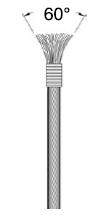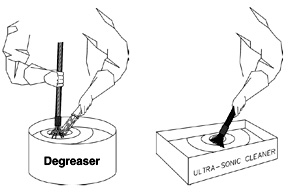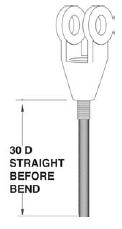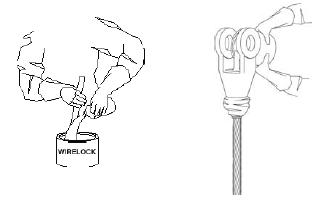Wirelock
WARNING |
•Incorrect use of WIRELOCK• can result in an unsafe termination which may lead to serious injury, death, or property damage.
•Do not use WIRELOCK• with stainless steel rope in salt water environment applications.
•Use only soft annealed iron wire for seizing.
•Do not use any other wire (copper, brass, stainless, etc.) for seizing.
•Never use an assembly until the WIRELOCK• has gelled and cured.
•Remove any non-metallic coating from the broomed area.
•Non Crosby sockets with large grooves need to have those grooves filled before use with WIRELOCK•.
•Read, understand, and follow these instructions and those on product containers before using WIRELOCK• |
The following simplified, step-by-step instructions should be used only as a guide for experienced, trained users. For full information, consult our document WIRELOCK• TECHNICAL DATA MANUAL, API (AMERICAN PETROLEUM INSTITUTE) RECOMMENDED PRACTICE 9B, ISO standards, WIRE ROPE MANUFACTURERS CATALOGS, and WIRE ROPE SLING USERS MANUAL, THIRD EDITION.
STEP 1 - SOCKET SELECTION
1. WIRELOCK• is recommended for use with Crosby 416 - 417 Spelter Sockets. Structural strand requires a socket with the basket length approximately 5 rope diameters to achieve 100% efficiency. Consult The Crosby catalog for proper selection of Wire Rope or Structural Strand sockets.
2. For use with sockets other than Crosby 416 - 417 consult the socket manufacturer or Crosby Engineering.
3. Sockets used with WIRELOCK• shall comply with
Federal or International (CEN, ISO) Standards.
4. WIRELOCK•, as with all socketing media, depends
upon the wedging action of the cone within the socket
basket to develop full efficiency. A rough finish inside
the socket may increase the load at which seating will
occur. Seating is required to develop the wedging
action.
STEP 2 - MEASURE AND SEIZE
The rope ends to be socketed should be of sufficient length so that the end of the unlaid wires (from the strands) will be at the top of the socket basket. Seizing should be placed at a distance from the end equal to the length of the basket of the socket.
STEP 3 - BROOMING
Unlay the individual strands and fully broom out the wires of the wire rope and IWRC as far as the seizing. The wires should be separated but not straightened.
Cut out any fiber core.
Unlay the individual wires from each strand, including the IWRC, completely, down to the seizing.
Remove any plastic material from broomed area.
STEP 4 - CLEANING
The method of cleaning will depend on the lubricant and/ or coating on the wire.
The methods and materials used for cleaning should comply with the current EPA regulations.
Consult your Wire Rope supplier or Wire Rope manufacturer for recommended material and methods. Follow the solvent supplier's recommendations for cleaning the broomed end.
STEP 5 - POSITIONING OF SOCKET
Position socket over the broom until it reaches the seizing on the wire rope. The wires should be LEVEL with the top of the socket basket.
Clamp rope and socket vertically ensuring alignment of their axes.
CAUTION: DO NOT USE OVERSIZED SOCKETS FOR WIRE ROPE.
STEP 6 - SEAL SOCKET
Seal the base of the socket with putty or plasticine to
prevent leakage of the WIRELOCK•.
STEP 7 - WIRELOCK• KITS
WIRELOCK• kits are pre-measured and consist of two (2) containers - one (1) with resin and one (1) with granular compound.
Use the complete kit - NEVER MIX LESS THAN THE
TOTAL CONTENTS OF BOTH CONTAINERS.
3. Each kit has a shelf life clearly marked on each
container and this must be observed. NEVER USE
OUT OF DATE KITS.
CAUTION |
•WIRELOCK• resin, in liquid state, is flammable.
•Chemicals used in this product can give off toxic fumes and can burn eyes and skin.
•Never use out-of-date material.
•Use only in well-ventilated work areas.
•Never breathe fumes directly or for extended time.
•Always wear safety glasses to protect eyes.
•Always wear gloves to protect hands.
•Avoid direct contact with skin anywhere. |
STEP 8 - MIXING AND POURING
Mix and pour WIRELOCK• within the temperature range of 48 degrees to 110 degrees F. Booster kits are available for reduced temperatures.
Pour all the resin into a container containing all the granular compound and mix thoroughly for two (2) minutes with a flat paddle.
Immediately after mixing, slowly pour the mixture down one side of the socket until the socket basket is full.
Check for leakage at nose of socket, add putty if required.
STEP 9 - CURING
WIRELOCK• will gel in approximately 15 minutes, in a temperature range 65 degrees F to 75 degrees F.
The socket must remain undisturbed in the vertical position for an additional ten (10) minutes after gel is complete.
The socket will be ready for service 60 minutes after gelling.
Never heat sockets to accelerate gel or curing.
STEP 10 - RE-LUBRICATION
Re-lubricate wire rope as required.
STEP 11 - PROOF LOADING
Whenever possible, the assembly should be proof loaded. All slings with poured sockets, in accordance with ASME B30.9, shall be Proof Loaded.
ALTERNATE SEIZING AND BROOMING METHOD
Reference the WIRELOCK• TECHNICAL DATA MANUAL from Crosby for an alternative socketing method.
|












